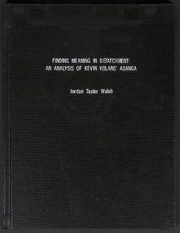
Finding Meaning in Detachment: An Analysis of Kevin Volans' Asanga PDF
Preview Finding Meaning in Detachment: An Analysis of Kevin Volans' Asanga
FINDING MEANING IN DETATCHMENT: AN ANALYSIS OF KEVIN VOLANS' ASANGA Jordan Taylor Walsh COLUMBUS STATE UNIVERSITY FINDING MEANING IN DETATCHMENT: AN ANALYSIS OF KEVIN VO LANS’ ASANGA A THESIS SUBMITTED IN PARTIAL FULFILLMENT OF THE REQUIREMENTS OF THE HONORS COLLEGE FOR HONORS IN THE DEGREE OF BACHELOR OF MUSIC IN MUSIC PERFORMANCE COLLEGE OF THE ARTS BY JORDAN TAYLOR WALSH COLUMBUS, GEORGIA 2016 FINDING MEANING IN DETATCHEMENT: AN ANALYSIS OF KEVIN VO LANS' ASANGA By Jordan Taylor Walsh Committee Chair: Dr. Paul Vaillancourt Committee Members: Dr. Matthew McCabe Dr. Rylan Steele Signature Page Approved Paul Vaillancourt Columbus State University May 2016 ABSTRACT Despite the undeniable importance of Kevin Volans' music, there has been little academic research done on his work. This is especially true of his pieces for percussion. This paper both dissects the form and structure Volans' piece for multiple percussion Asanga and explores the different interpretations by players from around the world that have contributed to the accepted performance practice for the piece. The ultimate goal of this project is to achieve a detailed understanding of how Asanga works and record this knowledge for the benefit of any future percussionists who add the piece to their repertoire. INDEX WORDS: Asanga, Kevin Volans, Multiple Percussion, Multi-percussion IV TABLE OF CONTENTS LIST OF TABLES v LIST OF FIGURES vi SIGNATURE PAGE vii INTRODUCTION 1 COMPOSER HISTORY 1 COMPOSITIONAL TENDENCIES 2 ASANGA’S HISTORY 3 INSTRUMENT CHOICES 6 FORMAL STRUCTURE 12 INTERPRETATION AND MALLET CHOICES 19 CONCLUSION 20 APPENDICES 22 BIBLIOGRAPHY 24 V LIST OF TABLES Table 1 Occurrence and description of each recurring motive in Asanga 13 Table 2 The order of measures in the large 2 section, split into four major parts 18 VI LIST OF FIGURES Figure I Set-Up for Circles, by Luciano Berio: a First Generation Composition 5 Figure II Bone Alphabet, by Brian Ferneyhough: a Second Generation Composition 6 Figure III Specific instrument requests in Asanga 6 Figure IV My Set-Up (See Appendix A for additional photographs) 10 Figure V 7/16 motive that disrupts the groove in both large 1 sections 14 Figure VI 3-3-2 ordering that concludes three of the four parts of the large 3 section 16 Figure VII The first iteration of the E motive, also the first piano dynamic of the piece 20 VI1 Finding Meaning in Detachment: An Analysis of Kevin Volans’ Asanga by Jordan Taylor Walsh A Thesis Submitted in Partial Fulfillment of Requirements of the Honors College for Honors in the Degree of Bachelor of Music in Music Performance College of the Arts Columbus State University Committee Meml Dr. Matthew McCabe Honors Committee Member Honors College Dean Dr. Gfhdy Ticknor 1 The problem of interpretation permeates all academic music. Issues of function within the music, as well as external forces acting upon the composer such as his or her intentions, place in history, and outside influences, are critical to the preparation of nearly all serious compositions. Performers often solve these issues by reading any accompanying text by the composer and studying the score. What is a musician to do, then, when the composer offers no guidance, or even states that there is no deeper meaning under the notes that he or she has written? Problems such as these exist in Kevin Volans' multiple- percussion work Asanga and can fortunately be addressed with a detailed analysis. This paper will explore connections between sections, instrument choices, structural points, and as a result achieve a deeper understanding of this piece that claims not to have any deeper meaning. Kevin Volans was born in 1949 in Pietermaritzburg, South Africa to Eunice and Jack Volans, who owned a local dry cleaner. He proved to be an intelligent child, excelling in English and math as well as quickly mastering the piano (by his twentieth birthday he had already performed several concerti with the Johannesburg Symphony Orchestra). He enrolled at the University of Natal in 1967 and began studies in both engineering and architecture but ultimately decided to pursue music as a career and auditioned for the music department of the University of the Witwatersrand in 1968.1 During his time at Witwatersrand, Volans studied primarily with Geoffrey Chew, June Schneider, and on occasion Peter Klatzow. However, it would be in 1970 that Volans 1 Lucia, Christine. "Celebrating Composer Kevin Charles Volans, B. 1949."Musicus 37.1 (2009): 3-18. Web. 13 Oct. 2015.
